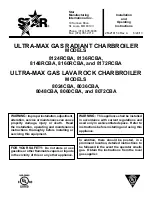
38
5.6
Cleaning the system
Before installing the appliance on a newly constructed system
or replacing a heat generator on an existing system, it is impor-
tant that the system is thoroughly cleaned to remove sludge,
slag, dirt, residue etc.
Before removing an old heat generator from an existing sys-
tem, it is recommended that the user:
– puts a descaling additive into the water system
– allows the system to work with the generator active for a few
days
– drains the dirty water from the system and flushes the sys-
tem with clean water once or more than once.
If the old generator has already been removed or is not availa-
ble, replace it with a pump to circulate water in the system and
then proceed as described above.
Once cleaning operations have been carried out and before in-
stalling the new appliance, it is recommended that a fluid is
added to the water system to protect it from corrosion and de-
posits.
m
CAUTION
– For further information on the type of additive and
usage, please contact the appliance manufacturer.
– Please remember that you
MUST
install a filter (not
supplied with the appliance) on the heating system
return (R).
5.7
Characteristics of feedwater and system
treatment
– All recirculatory systems will be subject to corrosion unless
an appropriate water treatment is applied. This means that
the efficiency of the system will deteriorate as corrosion
sludge accumulates within the system, risking damage to
pump and valves, boiler noise and circulation problems.
– Before connecting the boiler the associated central heating
system must be flushed in accordance with the guidelines
given in BS 7593 “Treatment of water in domestic hot water
central heating systems”.
–
Sime Ltd
recommends only the use of FERNOX products for
the flushing and final treatment of the system water. This is
particularly important in hard water areas. Failure to flush
and add inhibitor to the system may invalidate the appliance
warranty. Artificially softened water must not be used to fill
the heating system. Naturally soft water areas can corrode
aluminium heat exchangers. Adding Fernox F1 or Mb-1 will
guard against corrosion.
–
Sime Ltd
promote the fitting of TF1 System filter with any new
boiler installation.
– It is important to check the inhibitor concentration after in-
stallation, system modification and annually on a service visit
in accordance with the manufacturer’s instructions. (Note
on benchmark service record this has been complete). Test
kits are available from inhibitor stockists; the return of the
Fernox test report should be kept with the Benchmark to val-
idate warranty.
– Where Central heating systems are susceptible to freezing
a mixture of inhibitor and anti-freeze should be added in ac-
cordance with the DWTA code of practice and the Manufac-
tures instructions.
– The addition of sealing agents to system water is not rec-
ommended because deposits can be left in heat exchanger
causing circulation issues.
5.8
Boiler installation
Before mounting the
Murelle Revolution 30
boiler on the wall,
check that:
– the wall is solid
enough to support the weight
– the required minimum clearance zones are respected
– it is an outside wall or one which allows the user to respect
the maximum length of the air inlet and outlet pipes (Ø =
160/200 mm) (6 metres in total)
– the smoke outlet allows the user to respect the maximum
length of the pipe (maximum permitted load loss)
– the water and gas supplies are easily accessible.
m
CAUTION
Attach the four circular spacers (1) supplied in front of
and behind the fittings (2).
914
70
70
2
1
Fig. 53
Then:
– mark the two points where the holes are to be made to insert
suitable expansion plugs that support the weight of the boiler
– mark the points where the holes (Ø 164 mm) are to be made
to pass the air inlet and outlet and smoke outlet pipes through
Ø160/200
Ø160/200
Ø80
82,5
71
135
391
208
172
208
330
165
135
165
Fig. 54
– mount the boiler safely on the wall.
















































